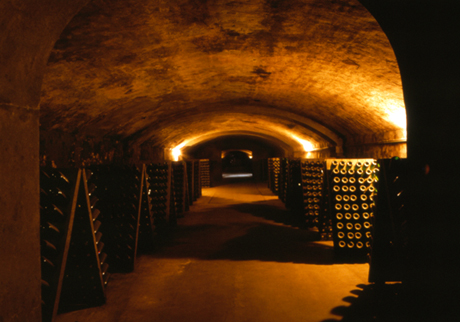
Name
Alta Langa
Seal of quality
A.O.C
A.O.C Guarantee of Origin. – D. M. 31 ottobre 2002
Description
Alta Langa DOC is a sparkling wine produced according to the classic method using Pinot Nero and Chardonnay grapes. The classic method being that which makes it compulsory in order to obtain the characteristic “foam” of a second natural fermentation in the bottle. The production cycle of the classic method spumante can be summarised as follows:
- The manual harvesting of the grapes into crates;
- preparation of the basic wine by means of the selection and soft pressing of the grapes, the fermentation of the must, and stabilization, and the addition to the wine of saccharose, yeasts and “liqueur de tirage”;
- placed in the bottle with temporary closure (special crown cap with bibule);
- storage of the bottles that are stacked in storage rooms at a temperature of between 10°-14° C, where the re-fermentation and the foam process occurs;
- wine maturing on yeast
- remuage positioning of the bottles on the pupitres (special stands);
- then follows a process that eliminates the yeasts that have acted inside the bottles;
- topping up of the bottles with the eventual addition of liqueur d’expedition;
- definitive capping with mushroom shaped cork secured to a metallic frame.
Alta Langhe wine requires a minimum maturing period of at least 30 months. May be produced I both rose and white versions. It has a fruity bouquet with subtle notes reminiscent of yeast, bread crust, and vanilla with a dry, tasty and well balanced flavour.
Area of production
It is produced using grapes originating from the provinces of Alessandria, Asti and Cuneo, according to the production standard. For the Province of Cuneo in the comunes of Alba (the area on the orthographic right of the Tanaro river), Albaretto Torre, Arguello, Bastia Mondovì, Belvedere Langhe, Benevello, Bergolo, Bonvicino, Borgomale, Bosia, Bossolasco, Briaglia, Camerana, Camo, Carrù, Castellino Tanaro, Castelletto Uzzone, Castiglione Tinella, Castino, Cerretto Langhe, Ceva (the area on the orthographic right of the Cevetta river up to the confluence of the Tanaro, and from here the area to the orthographic right of the Tanaro river), Cigliè, Clavesana, Cortemilia, Cossano Belbo, Cravanzana, Diano d’Alba, Dogliani, Farigliano, Feisoglio, Cissone, Gorzegno, Gottasecca, Grinzane Cavour, Igliano, Lequio Berria, Levice, Mango, Marsaglia, Mombarcaro, Monchiero, Mondovì (land sto the orthographic right of the Ellero river, right up to the inhabited area south of Mondovì, and then proceeding towards the North- East, the lands to the right of the main road. n° 28 for Fossano, up to the communal border with Magliano Alpi), Monesiglio, Monforte d’Alba, Montelupo Albese, Murazzano, Neviglie, Niella Belbo, Niella Tanaro, Novello, Paroldo, Perletto, Pezzolo, Valle Uzzone, Piozzo, Prunetto, Roascio, Rocca di Cigliè, Rocchetta Belbo, Roddino, Rodello, Sale Langhe, Sale San Giovanni, Saliceto, San Benedetto Belbo, Santo Stefano Belbo, Serralunga d’Alba, Serravalle Langhe, Sinio, Somano, Torre Bormida, Torresina, Treiso, Trezzo Tinella, Vicoforte.
All the vines must be located at a minimum height of 250 m asl.
History
The history of Alta Langa wine began in 1990 with a return to the origins, with the intention of confirming the vocation of the hills of the Langhe and Monferrato in the production of Pinot nero and Chardonnay grapes in the production of Spumante according to the classic method. This has required a series of studies and scientific investigations with the support of the Experimental vine cultivation institute – operation section of Asti. The first months being dedicated to the identification of the necessary environmental features necessary to produce quality sparkling wines. These fact finding investigations were further intensified during the harvest of 1990 when steps were made to assess the behavioural features and the maturation trends of the grapes located in numerous existing vines., at the end of ’91, the zone of origin of the Classic Method Spumante in Piedmont was identified. Although the production output of the first 20 hectares of experimental plants did not occur until 1994.
The experimental stage lasted until 1996 when the last planted experimental vines came into production, bringing the total experimental surface area to over 48 hectares. In 1999, with a total of 50 hectares in full production, it began to be termed the productive sector, and steps were made to apply for D.O.C. status obtained with a M.D dated 31st October 2002. The year 2001 saw the constitution of the Consortium for the Protection of the “Alta Langa”.